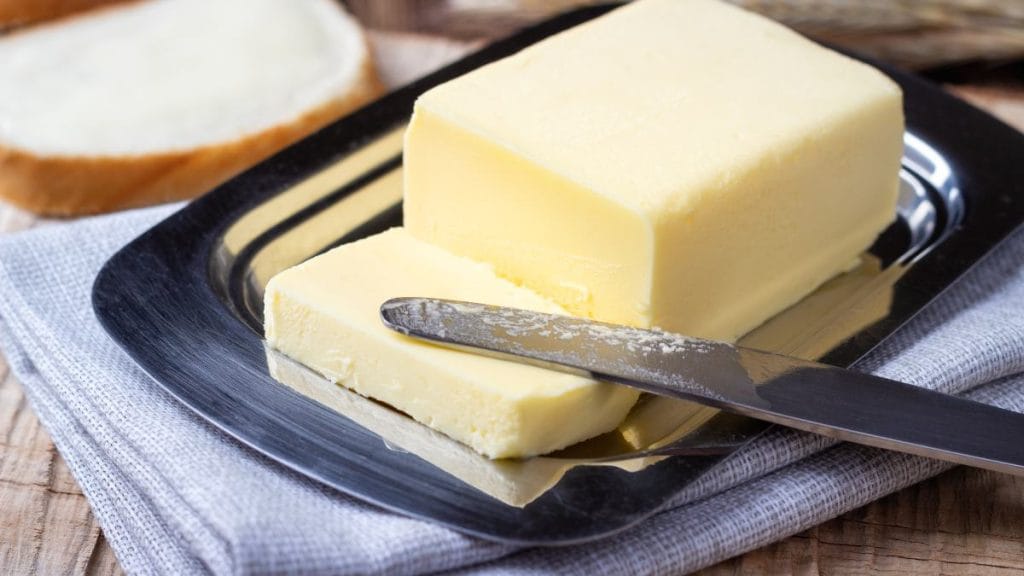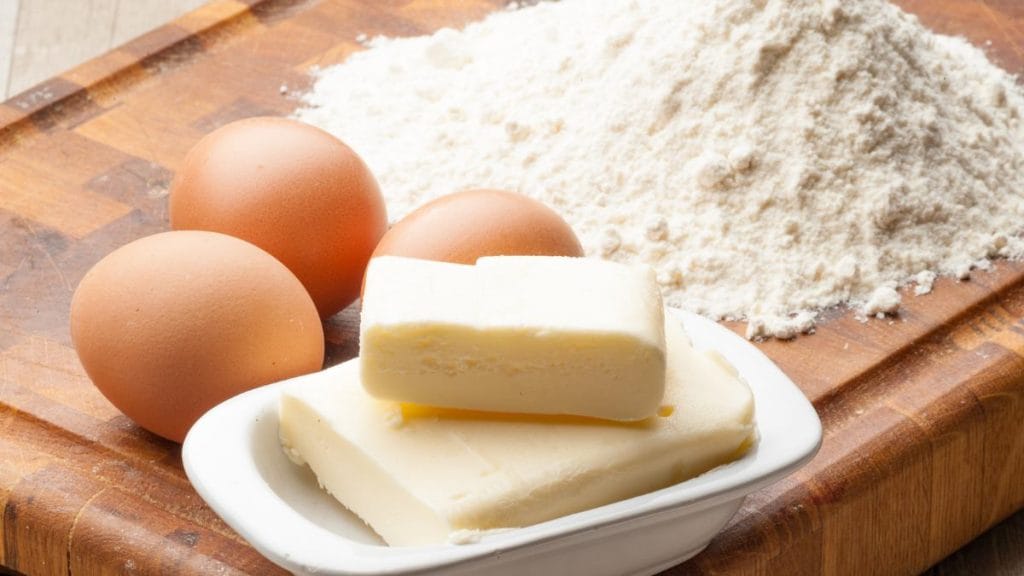Measuring and softening butter accurately makes cooking and baking recipes turn out just right. By using a few simple strategies and our handy conversion chart, anyone can easily prepare butter for the best results.
First: what are you making? This will determine what your butter should be like. Softened butter is best for baking and spreading. It combines evenly for cakes, cookies, and icing, ensuring fluffier, lighter results. Cold butter is key for recipes requiring flaky layers, like biscuits and pie dough—here, you want the butter to stay solid as you work. Melted butter is for adding richness to sauces or giving brownies their signature fudgy bite—it delivers moistness but less structure.
Five Ways to Measure Butter
Using Wrapper Lines
Butter in Canada is typically sold as 454 g (1 lb) blocks, equal to 2 cups (500 mL). Most brands print measurement lines for 1/2 cup (125 mL), 1/4 cup (60 mL) and other usual volumes directly on the wrapper, making it simple to slice what’s needed for a recipe—no special equipment required. Recipes from the United States often call for a ‘stick’ of butter, which is equal to 1/2 cup or 8 tablespoons (125 mL).
Using a Ruler
If the wrapper on the butter block is missing measurement lines, a ruler can be very helpful. Since a standard block is equal to 2 cups, use the ruler to measure the amount you need and slice off the correct portion. For example, if you need 1 cup (250 mL), measure out half the block; for 1/4 cup (60 mL), measure one eighth of the block in length.
Marking a New Block
When opening a new block of butter, use a knife to gently mark scoring lines across the top in the amounts you most often use, such as 1/4 cup (60 mL) segments. These shallow marks will remain visible even after you cut off and rewrap the butter, providing a simple and reusable reference for later slices.
Water Displacement Method
When the butter is in chunks or not in its block form, the water displacement method works well. Fill a liquid measuring cup (a 2-cup size or larger works well) with water to about 1 cup (250 mL), then add the butter pieces until the water rises to your new measurement. The difference between the two numbers tells you exactly how much butter you have, making it easy to measure even irregular pieces without guesswork.
Measuring Softened Butter
If your recipe calls for softened butter, press it into a dry measuring cup using a firm spatula. This helps remove any trapped air and ensures you’re using the right amount. Be sure to level the top with the straight edge of a butter knife or spatula for accuracy before adding it to your recipe.

Butter Conversion Chart
| Butter Amount | Cups | Tablespoons | Grams | Sticks (US) |
|---|---|---|---|---|
| Block (Full) | 2 cups (500 mL) | 32 Tbsp | 454 g | 4 |
| 1 cup | 1 cup (250 mL) | 16 Tbsp | 227 g | 2 |
| 1/2 cup | 1/2 cup (125 mL) | 8 Tbsp | 115 g | 1 |
| 1/4 cup | 1/4 cup (60 mL) | 4 Tbsp | 58 g | 1/2 |
Methods to Soften Butter
Perfectly softened butter (18–22°C) means easier mixing for cakes, cookies, and spreads. It’s all about structure—as butter softens, it creams and combines smoothly with sugar, and helps dough hold together for that irresistible texture and lift.
Sit at Room Temperature
The most reliable way to soften butter is to let the desired amount sit at room temperature for about 1 to 2 hours. Try to place it in a spot that is out of direct sunlight but comfortably warm. If your kitchen is cooler, it may take a little longer, and if your kitchen is warmer, the process could be quicker. Check the butter periodically so that you know when it’s ready.
Shave Thin Slices for Spreading
When you’re short on time and want butter soft enough to spread, slice paper-thin pieces off the block with a cheese plane or sharp knife. These thin slices warm up quickly, especially on freshly toasted bread, making them easy to enjoy in minutes without waiting for the whole block to soften.

Cut into Cubes for Baking
For baking, cut the butter into smaller chunks or cubes before leaving it to soften. Smaller pieces will reach the right texture much faster than a whole block. This approach also means you only need to soften the exact amount the recipe calls for, reducing waste and saving time.
Grating
If you have a block of butter that’s cold or even frozen, use the coarse side of a box grater to shave off thin pieces. These shredded bits will quickly come to room temperature, making them easy to mix into batters or doughs even on a busy schedule.
Microwave Softening
To soften butter in the microwave, start by cutting it into small chunks and spreading them out on a plate. Cover loosely with a paper towel and use low power (about 30%) for just a few seconds at a time. Pause every 5–10 seconds to check the texture — you want it soft, not melted. Melted butter can affect baking results by making dough chewy instead of light and fluffy.
Steam Softening
Another gentle method is to harness steam in your microwave. Heat a cup of water until very hot, then remove it and quickly put your sliced butter on a plate inside the microwave. Close the door (without turning the microwave on) and let the residual warm air and steam soften the butter over several minutes. This method helps prevent accidental melting and can be useful when prepping several batches.
Empowering Your Kitchen Confidence
Butter is a staple in many kitchens, and with a few simple techniques, it’s easy to measure, soften, and use well in a variety of recipes. Taking a bit of time to get comfortable with these steps will help make everything from baking to spreading a little smoother and more enjoyable for everyone sitting down to eat.

Frequently Asked Questions
When should I use soft butter, cold butter or melted butter?
Softened butter is best for baking and spreading. It combines evenly for cakes, cookies, and icing, ensuring fluffier, lighter results.
Cold butter is key for recipes requiring flaky layers, like biscuits and pie dough—here, you want the butter to stay solid as you work.
Melted butter is for adding richness to sauces or giving brownies their signature fudgy bite—it delivers moistness but less structure.
How is butter typically sold and measured in Canada?
Butter in Canada is usually sold in 454 g (1 lb) blocks, which equals 2 cups (500 mL). Most blocks have measurement lines printed on the wrapper to help you portion common amounts easily.
What should I do if my butter wrapper doesn’t have measurement lines?
Use a ruler to measure out the amount you need, knowing the full block is equal to 2 cups (500 mL). You can also score the top with a knife into segments so you can see measuring marks even after cutting and rewrapping.
How do I measure softened butter correctly?
Use a firm spatula to press softened butter into a dry measuring cup or spoon, making sure to press out any air pockets. Level off the top for an accurate measurement before using in your recipe.
What is the water displacement method for measuring butter?
If your butter is in multiple pieces and not in a nice neat block, you can use water to tell you exactly how much butter you have.
- Pour some cold water into a measuring cup. Make sure there will be enough room for the butter and the water without spilling.
- Before you add the butter to the water, make note of exactly how much water is in the measuring cup. How much water are you starting with?
- Now drop the butter gently into the water in the measuring cup. The water will rise.
- Note where the water line is now after adding the butter.
- Calculate the difference between the first amount of water and the second amount of water. The difference is how much butter you’ve got.
For example, if the water went from ½ cup (125 mL) to ¾ cup (175 mL), that means you’ve got ¼ cup (60 mL) of butter.
What are some quick ways to soften butter for spreading or baking?
Let butter sit out at room temperature for 1–2 hours. For faster results, slice it thinly or grate it to create smaller pieces that soften quickly. Using the microwave on low power in short bursts can also work—but you will need to check frequently to avoid melting completely.
How does softened butter affect baking outcomes?
Softened butter mixes more evenly with other ingredients, which helps recipes like cakes and cookies rise and turn out light in texture. Melted butter is best saved for recipes where a denser result is desired, like brownies.
Is Canadian butter measured differently than in other countries?
Yes, Canadian recipes typically use metric measurements (grams or millilitres) or cups, while US recipes often reference ‘sticks’ and some European recipes call for weight in grams or ounces. Always check your recipe and use the included conversion chart for help.





 Our Nostalgic Views Of Farming No Longer Match Modern Farming
Our Nostalgic Views Of Farming No Longer Match Modern Farming